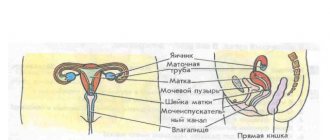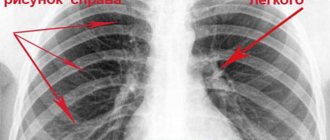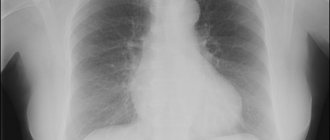#!RentgenNA4ALO!#
Almost every woman knows that breast health needs to be monitored especially carefully. The greatest attention should be paid to the breast in the postpartum period, at the onset of menopause, and also in case of an unfavorable prognosis for oncology. In addition to palpation and visual examination, as well as a number of tests, the doctor may prescribe you a type of examination such as mammography - this diagnosis is done using an X-ray, ultrasound or MR machine.
X-ray signs of breast cancer on mammography
X-ray signs of gland cancer (breast):
- Darkening from the tumor node.
- Intense shadows of microcalcifications.
- Deformation of the vascular pattern.
- Restructuring of gland tissue.
- Nipple retraction.
- Pulling the pathological shadow to the chest wall.
- The presence of enlarged lymph nodes.
Photo of mammograms: picture a – glandular tissue is partially replaced by adipose tissue;
b – glandular tissue is completely absent in a woman in menopause. The first X-ray signs of a malignant formation in the gland are focal accumulations of calcifications (deposition of calcium salts). To determine this symptom, the radiologist must have sufficient qualifications.
In women, small calcifications are often detected in the glandular tissue during mammography, but they do not always indicate cancerous degeneration of the tissue.
These signs suggest cancer “in cito”, therefore, according to the recommendations of the American Cancer Society, women after 40 years of age must undergo an X-ray examination once every 2 years.
X-ray with contrast
Also, during the X-ray process, it is possible to identify diseases of the pancreas.
This diagnosis comes in two types:
- contrasting
- non-contrast
An x-ray can reveal a serious disease such as pancreatitis. Inflammation of the pancreas is associated with a violation of the outflow of juice produced by the digestive system and enzymes. The main reason for the appearance of this disease lies in poor nutrition, abuse of toxic substances and environmental degradation.
The images that were obtained as a result of an x-ray of the pancreas with pancreatitis can be viewed in the photos provided.
To take an X-ray of the pancreas using contrast, you need drugs that contain iodine.
Thanks to the coloring matter, the following occurs:
- Improving the contrast of the organ in the image.
- Neoplasms and metastases become more noticeable.
- It is possible to obtain an image of the vessels that are located in the abdominal cavity.
There are several ways in which contrast can be introduced into the human body:
- through intravenous administration. This method allows you to increase the contrast and neoplasms. Based on the goals, the drug can be administered in a stream and once or in a bolus and dosed.
- administration of the dye solution through the mouth. This method allows you to obtain more informative images showing the structure and function of the pancreas.
After the drug is injected into the blood, pain may appear in the place where the injection was given. There are also flashes of heat and a taste of something sour or metallic. These reactions are safe and will not interfere with further diagnostics.
X-ray with contrast
If one of the symptoms listed below appears, you should urgently seek medical help:
- swollen face and limbs;
- a sore throat;
- skin itching and rash;
- low blood pressure;
- bronchospasm.
The risk of allergies is high in people who suffer from bronchial asthma and are unable to tolerate drugs or products containing iodine.
Disorders of the pancreas
X-ray signs of breast enlargement in women
Mammography allows you to determine not only cancer, it shows the following pathology:
- nodular mastopathy;
- inflammatory changes;
- abscesses;
- changes in the course of the milk ducts;
- sclerotic age-related changes in glandular tissue.
A diagnostic x-ray examination of the mammary glands in women shows signs of benign nodes, which can transform into malignant formations over time.
What may appear on an x-ray during external breast enlargement:
- A clear change in the glandular structure is due to inflammation.
- Localized deformity – cancer “in place”.
- Disruption of blood vessels - mastopathy or tumor. The diagnosis will become known after receiving the results of a microscopic examination of cells taken from the pathological area with a needle.
- Diffuse microcalcifications – inflammation.
- Limited accumulation of calcium salts – gland cancer.
Preparation and methodology for conducting the survey
How to prepare for mammography of the mammary glands, and what is the preparation procedure? The examination is painless, but due to the individual characteristics of the body, it may cause some discomfort. In this case, it is possible to take painkillers before the study. Directly on the day of the examination, it is prohibited to use deodorant and other cosmetics that should be applied to the skin of the armpits. This is due to the fact that they may cause dark spots to appear on the film, which will prevent an accurate diagnosis.
How a description protocol is formed for mammography
Photo of a galactogram: a – normal branching of the milk ducts;
b – small cysts The protocol for describing an x-ray examination of the gland includes 3 options for forming a radiologist’s conclusion:
- The mammogram revealed no structural abnormalities.
- The structure of the glandular tissue remains unchanged over a large extent, but areas of deformation have been identified. Recommended: control x-ray after 4-6 months.
- If deformed areas of tissue or focal accumulation of calcium salts are detected, a biopsy is prescribed (taking a piece of tissue with a needle for histological examination).
If there are no X-ray signs of cancer on a mammogram, its absence cannot be completely ruled out. According to famous radiologists, a malignant tumor can be detected on an image when it measures from 1 to 1.5 cm.
When using digital x-rays of glands in women, the reliability of the study increases, since the equipment is able to detect tumors up to 0.8 cm in diameter.
How often can I do it?
Mammography is carried out as a preventative measure for all women over 40 years of age once every 2 years. At the discretion of local institutions for the female population over 50 years of age - once a year.
In addition, there are unscheduled indications for this type of examination.
Carrying out a mammogram while breastfeeding is completely acceptable.
During pregnancy at any stage, it is preferable to use the ultrasound method due to the absence of side effects, primarily radiation exposure to the body of the mother and fetus. Carrying out a mammogram during breastfeeding is quite acceptable, but it is not very informative for a doctor. It is recommended to use other auxiliary studies.
It is considered most correct to undergo a mammological examination on days 5-13 of the menstrual cycle, i.e. in the first phase. In the second phase, the breast tissue undergoes some hormonal changes: the ducts expand, the structure of the glandular component changes, and swelling of the soft tissues may appear. In this case, the result may be unreliable, and the examination will be endured with a feeling of discomfort and pain.
According to basic recommendations, mammography should be performed no more than once a year. But in urgent cases, up to 2-3 times are allowed. If more frequent examinations are necessary, it is reasonable to use auxiliary methods - ultrasound (ultrasound), magnetic resonance imaging (MRI).
Mammography is carried out in the X-ray room, where the mammography machine is located. The woman is shown how to position herself next to him. The position depends on the type of equipment (standing or sitting). Next, a protective apron made of lead material is placed on the waist area, covering the lower abdomen. The mammary glands are placed on a plate intended for this purpose, and the chest is pressed on top with a similar plate.
The mammary glands are placed on a plate intended for this purpose, and the chest is pressed on top with a similar plate.
If a pathology is detected, the woman may additionally undergo radiography in a different projection - lateral and/or oblique. At the discretion of the doctor, a targeted mammography is possible, when the affected area of the gland is directly imaged on an enlarged scale.
A photo with a description can be received on the same day. Some clinics are equipped with digital equipment that provides more detail in the resulting image. All information can be saved on electronic media and used at any time.
On the first day, a woman may complain that her breasts hurt after a mammogram. This is due to the mechanical pressure of the plates, does not last long and eventually goes away on its own.
Other X-ray examinations should be rescheduled on this day so as not to exceed the permissible radiation dose.
What does a radiologist see in breast images?
On photographs of the glands, the radiologist notes 3 groups of signs:
- primary – shadows of a pathological node;
- secondary - darkening, reflecting the pathological process around the primary source;
- indirect - radiological symptoms of an advanced process, indicating the spread of pathology to most of the gland.
Breast cancer is most often detected on x-ray based on primary and secondary symptoms. Pathological tumor darkening and deformation of the glandular tissue around it are clearly visible on the x-ray. The above symptoms appear when the cancerous node is larger than 10 mm.
Secondary signs of a malignant tumor on a mammogram:
- cancerous lymphangitis (inflammation of the lymphatic vessels);
- reactive inflammation;
- atrophy and transformation of glandular tissue;
- compression of an organ by a malignant node.
Photo: contrast-enhanced cysts
Most often, cancer is localized in the upper outer quadrant. This area is accessible for digital examination, so women are sent for mammography when tissue compaction is detected in this area.
Other forms of the disease cannot be diagnosed during examination, so the Ministry of Health has obligated women over 40 to undergo screening radiography.
Indications for the study
X-ray examination is divided into 2 types: preventive and diagnostic. The first is prescribed to all women who have reached the age of 35, and if there is a genetic predisposition to cancer, the threshold is reduced to 30 years. It is better to have a mammogram of the mammary glands from this age for the reason that when a girl or woman is still young, her breasts are more dense. The results of the study may be unreliable.
Absolute readings
In some situations, x-ray examination is mandatory. Otherwise, there is a high risk of missing malignant tumors that are beginning to develop, including cancer.
Seals in the thickness of the mammary gland
The doctor usually determines this deviation from the norm during a palpation examination. The woman herself can detect it by doing a breast self-examination. Since lumps may indicate the development of a tumor, even in the absence of other frightening symptoms, you should immediately undergo an examination.
Various discharge from the nipple, its deformation
Preparation for mammography of the mammary glands will also be required in the case of nipple discharge. The liquid may be clear, yellowish or pinkish. Bloody and purulent discharge should be especially alarming - they often indicate a malignant neoplasm.
Breast pain, swelling, increase or decrease in size
Painful sensations are associated with purulent inflammation, benign and malignant tumors, and sometimes with neurological and cardiovascular diseases. To confirm the diagnosis, a mammogram of the mammary glands is done before giving a final answer.
Swelling or retraction of any part of the breast
The reason for the change in breast shape, if it is not age-related deformations or the period after pregnancy and lactation, may be in the diseases already identified earlier. In this and all of the above cases, mammograms should be done as often as your doctor requires.
Relative readings
Having understood what mammography is, how this study is done and when it is necessary, it would be correct to move on to the list of diagnoses for which X-ray diagnostics are not necessary, but desirable. The decision in this case is made jointly by the doctor and the patient.
Mastopathy
The study allows you to: make sure that the cyst is benign, determine the volume of the tumor, and the likelihood of surgical intervention.
Obesity
This condition provokes not only diseases of the heart and blood vessels, as well as the musculoskeletal system, but can become a prerequisite for breast cancer.
Inflammatory diseases (mastitis)
X-ray diagnostics is done if the doctor cannot palpate the cause of pain and enlargement of the mammary gland or suspects mastitis, but needs to confirm the diagnosis.
Infertility
X-ray of the mammary glands in this case is of a preventive nature, since women suffering from infertility are more susceptible to cancer.
History of surgical interventions on the mammary glands
Breast mammography is also done after the patient’s breast has been operated on (for example, when a tumor or cystic neoplasm is removed). Here, the purpose of the examination is to monitor the situation over time in order to eliminate the risk of complications or relapse.
#!RentgenSeredina!#
Instrumental diagnosis of pancreatitis
Instrumental studies for pancreatitis are more informative when diagnosing a patient in a hospital. Examinations, diagnosis and subsequent therapy give the best results if the patient is admitted to the hospital on time. In the later stages, after the appearance of characteristic symptoms of pancreatitis and its complications, the disease is more difficult to diagnose. The specialist determines which diagnostic methods should be used (gastroscopy, MRI, etc.). Accurate diagnosis of chronic pancreatitis (MRI) will help you choose the right and timely treatment, avoid complications of the disease and other serious consequences.
Types of mammography
Traditional mammography - a woman’s breast is placed on a special stand, inside of which there is an X-ray machine exposure meter, and pressure is applied on top. The projection is selected depending on the plane in which the breast is pressed (this approach helps to expand the study area). Highlight:
- direct projection (the tube of the X-ray machine is directed from above);
- lateral projection (the tube is brought in from the outer edge);
- medial projection (X-rays pass from the inner edge);
- tangential and axial projections;
- contrast study - intravenous contrast is administered.
Treatment of thymus diseases
Treating any thymus disease is very difficult, and also takes a long time. For example, chronic autoimmune diseases cannot be cured at all, but only to reduce the level of their negative effects with the help of immunomodulators and B vitamins. This allows you to slightly improve the protective functions of the body and provides protection against other infectious diseases.
That is why it is very important to follow the doctor’s recommendations and take all prescribed medications, as this will help reduce the risk of destruction of still healthy organ cells. In addition, doctors also recommend following preventive measures and taking vitamins, especially in the autumn-winter period, when you need to strengthen your immune system more than ever.











